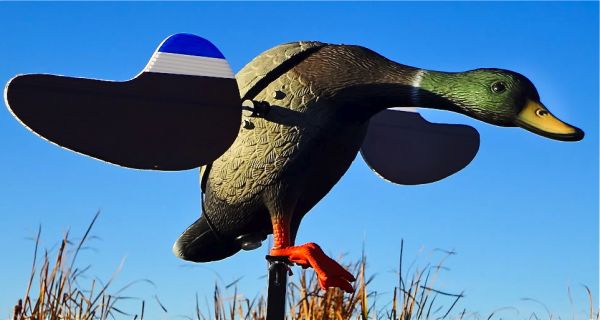
The definition of “mojo” is pretty straightforward: “a power that may seem magical and that allows someone to be very effective and successful.”
Never has the term been applied more aptly than in the world of waterfowling, where Mojo spinning-wing duck decoys have become standard operating equipment in deke spreads.
But how did it get started?
An unintentional discovery in the cold strawberry fields of California somehow found its way to Jeff Simmons’ duck blind one cold opening morning nearly 20 years ago.
And the story of the magic duck began.
“It was opening day, and I had a good friend hunting with me,” Simmons recalled. “He had a duck-hunting friend in from California and brought him along.
“That morning things were crazy. There were plenty of ducks, but they wouldn’t work the decoys. I was frustrated and about to give up when the guy from California pulled out a contraption that just seemed like it would make things worse.”
Simmons wasn’t very accepting of the proposed tactic.
“He had a set of battery-operated white fan blades mounted on a stick. He wanted to put it out in the decoys. He insisted it would attract ducks,” Simmons said. “I told him he was crazy, but he kept on and on, and I finally gave in. We weren’t killing ducks anyway.
“He put the stick in the mud and turned it on.”
The hunt turned around almost instantaneously.
“Before he got back in the blind, 20 mallards fell out of the sky into the decoys. We got about six of them,” Simmons said. “I laughed it off as a fluke. But before we could gather up the ducks, here came another group — this time about 30 mallards.
“In 20 minutes, the five of us had gone from no ducks to our limit. I was stunned.”
It turned out that the spinning fans were used at farms back in California.
“The guy told us that in the Sacramento Valley when the weather got too cold too early, they put these white fans out around the strawberry farms to move the air and keep the berries from freezing,” Simmons said. “Every time they turned on the fans, ducks would lock up and head straight for the fields, landing there even though there was no water or no logical reason. It turns out the ducks didn’t like strawberries; they liked those slow-turning fan blades and thought it was the wings of other landing ducks.”
Simmons decided to give the new tool a workout.
“We took the white fan back the next day and the next day and the next day,” he said. “Mojo decoys were born from that. At first, I wasn’t saying anything, but all my buddies hunting around me were freaking out. They said I was baiting the field, but I wasn’t.
“I finally showed one friend the stick fan, and he laughed me out of the field. But he went with me the next morning; I turned that thing on and 30 mallards fell in like somebody dropped them out of an airplane. He wasn’t laughing anymore. It was that stupid fan on a stick. He threatened to take mine if I didn’t get him one.”
It didn’t take him long for Simmons to begin thinking about how to market the fans.
“I may be stubborn, but I’m not stupid,” he said. “I figured if we could put spinning wings on a real decoy, it would be awesome — and we could sell them for $200 apiece.
“I called Murray Crowe, a friend from Sterlington who can build about anything. I took him some decoys and the magic duck stick. He took the motor out of his wife’s treadmill and put it in a decoy, built wings out of sheet metal, painted them like mallard wings and we took it hunting.
“We killed limits so fast it wasn’t even funny. By then the word was out.”
Business was crazy.
“He could build about 10 a day, and we had to sneak them into the store because we had several hundred people on a waiting list,” Simmons said. “We called people on the list into my office, sold them one apiece and made them take them out to their trucks in a brown paper bag so nobody would get in a fight over them.
“It was unbelievable. It was truly a once-in-a-lifetime deal.”
Simmons and his partners sold the Mojo business several years ago, but the Mojo’s success hasn’t slowed a bit.
You can find out more about today’s products at www.mojooutdoors.com, or you can find them at almost any sporting goods store.
